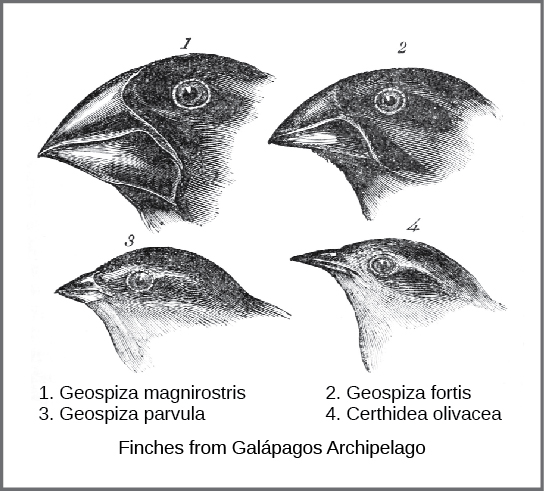How Does Darwim Explain the Differences in the Birds
Lamarck was a more versatile scientist than Darwin. Though Darwin didnt know what genes were he could see their effect on.
Evolution Of Darwin S Finches Integrating Behavior Ecology And Genetics Cornellcast
Struggle for Existence Survival of the Fittest.

. Darwins theory of evolution is based on the idea s of The shape and structure of the beak are inherited and help the pelican survive in its environment. In other words beaks changed as the birds developed different tastes for fruits seeds or insects picked from the ground or cacti. A team of scientists has now shed light on the.
Overproduction all species will produce more offspring than will survive to adulthood. There are about 13 species of this bird already present on the islands. Two major factors mentioned in Darwinism are the battle for life and survival of the fittest.
A bird with a long narrow beak probably ate seeds which were hard to crack 4. Epigenetics may be how Darwins finches rapidly change their beak size and shape in response to sudden environmental changes such as drought or human disturbance in the absence of gene mutations. Adaptation traits that increase suitability to a species environment will be passed on.
Darwins theory became even stronger when many years after his death the study of genetics emerged. Darwin wondered about the changes in shape of bird beaks from island to island. They belong to the tanager family and are not closely related to the true finches.
Why did Darwins finches evolve. Lamarckism refuses to accept Darwin s natural theory of selection. The closest known relative of the Galápagos finches is the South American.
There were 13 different species. Darwins finches are a group of about 18 species of passerine birds. The thinnest beak belongs to the green warbler finch which uses it to probe for insects.
How did Darwin explain the differences between the beaks of the birds. Darwin discovered that developing embryos contain certain traitslimbs that disappear before the organism is born. Darwin proposed that evolution takes place by means of natural selection as the fittest one survives.
Click to see full answer. Charles Darwins theory of evolution states that evolution happens by natural selection. Beaks of warbler finches are thinner and more pointed than both.
A group of birds he collected that were slightly different than those found on the nearby mainland caught his attention. These birds although nearly identical in all other ways to mainland finches had different beaksTheir beaks had adapted to the type of food they ate in order to fill different niches on the Galapagos Islands. These birds have since become known as Darwins Finches.
As a consequence those individuals most suited to their environment survive and given enough time the species will gradually evolve. Darwins observations that led to his theory of natural selection are. However Lamarck proposed that evolution takes place through inheritance of acquired characteristics.
The Darwins finches found on each island differ from the others by their size and the kind of beak that they possess. Darwins finches inhabiting the Galapagos archipelago and Cocos island constitute an iconic model for studies of speciation and adaptive evolution. They were not always finches but evolved from some other birds 3.
They are well known for their remarkable diversity in beak form and function. How did Darwin explain the data about the finches on the various Galapagos Islands. The birds differ in plumage and body size but the most obvious differences between the birds are the size and shape of their beaks which are dependent on their food preferences and specialisations.
Back in Britain Darwin learned that all of the birds he had collected were variations of a single type. Individuals in a species show variation in physical characteristics. However the Galapagos finches helped Darwin solidify his idea of natural selection.
They had evolved different beaks because of the. Group of answer choices 1. They are often classified as the subfamily Geospizinae or tribe Geospizini.
Darwinism does not believe in the concept of the internal vital force explained in Lamarckism. ADarwin thought that organisms could induce their own changes while Lamarck thought that change could only be induced by an organisms science In the Galapagos Islands Charles Darwin found many different species of finches a type of bird that seemed closely related. The difference between each of these species can be seen as an example of how nature helped the bird adapt to the conditions around it.
They must have all evolved on one island and then spread to others 2. These adaptations make them more fit to survive on available food. So-called cactus finches boast longer more pointed beaks than their relatives the ground finches.
Darwinism is more accepted than Lamarckism by the present-day scientific community. Darwin observed different species of finches with very different body sizes bill structures behaviors and even feeding preferences. What did Darwin discover while studying developing embryos snakes whales human.
Variation there are variations between members of the same species. Darwins theory of evolution suggests that variation and natural selection. Genetics ultimately showed that all inherited traits were passed on through genes which are unaffected by outside world as Lamarck would predict and are instead naturally varied as Darwin predicted.
Long pointed beaks made some of them more fit for picking seeds out of cactus fruits. Breakthroughs in a brand-new sciencenicknamed evo devoare linking the enigmas of evolution to another of. He proposed that the birds had all evolved from a common ancestor.
What Darwin Never Knew offers answers to riddles that Darwin couldnt explain.

Dna Reveals How Darwin S Finches Evolved

Darwin S Finches An Overview Sciencedirect Topics

18 1c The Galapagos Finches And Natural Selection Biology Libretexts
Comments
Post a Comment